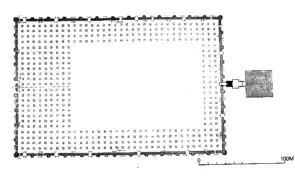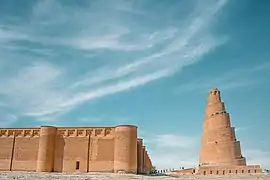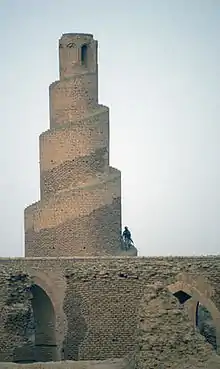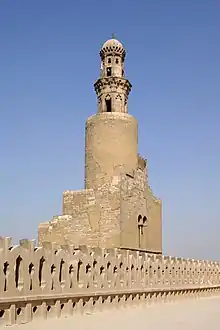| Great Mosque of Samarra | |
|---|---|
Arabic: جَامِع سَامَرَّاء ٱلْكَبِيْر مَسْجِد سَامَرَّاء ٱلْكَبِيْر ٱلْمَسْجِد ٱلْجَامِع فِي سَامَرَّاء | |
 The spiral minaret of the mosque | |
| Religion | |
| Affiliation | Islam |
| Ecclesiastical or organisational status | Mosque and shrine |
| Status | Active |
| Location | |
| Location | Samarra, Iraq |
 Location in Iraq | |
| Geographic coordinates | 34°12′21″N 43°52′47″E / 34.20583°N 43.87972°E |
| Architecture | |
| Type | Islamic |
| Style | Abbasid |
| Founder | Al-Mutawakkil |
| Date established | 848 CE |
| Completed | 851 CE |
| Destroyed | 1278 CE |
| Specifications | |
| Minaret(s) | 1 |
| Minaret height | 52 metres (171 ft) |
| Official name | Samarra Archaeological City |
| Criteria | Cultural: ii, iii, iv |
| Reference | 276 |
| Inscription | 2007 (31st Session) |
| Endangered | 2007- |
| Area | 15,058 hectares (37,210 acres) |
| Buffer zone | 31,414 hectares (77,630 acres) |
The Great Mosque of Samarra (Arabic: جَامِع سَامَرَّاء ٱلْكَبِيْر, romanized: Jāmiʿ Sāmarrāʾ al-Kabīr, Arabic: مَسْجِد سَامَرَّاء ٱلْكَبِيْر, romanized: Masjid Sāmarrāʾ al-Kabīr, or Arabic: ٱلْمَسْجِد ٱلْجَامِع فِي سَامَرَّاء, romanized: al-Masjid al-Jāmiʿ fī Sāmarrāʾ, lit. 'The Congregational Mosque in Samarra') is a mosque from the 9th century CE located in Samarra, Iraq. The mosque was commissioned in 848 and completed in 851 by the Abbasid caliph Al-Mutawakkil who reigned (in Samarra) from 847 until 861. At the time of construction, it was the world's largest mosque.[1] It is known for its 52 metres (171 ft) high minaret encircled by a spiral ramp. The mosque is located within the 15,058-hectare (37,210-acre) Samarra Archaeological City UNESCO World Heritage Site, listed in 2007.[2]
History
For a time, the mosque was the largest in the world; its minaret, the Malwiya Tower, is a spiralling cone 52 metres (171 ft) high and 33 metres (108 ft) wide with a spiral ramp.[3] The reign of Al-Mutawakkil had a great effect on the appearance of the city, for he seemed to have been a lover of architecture, and the one responsible for building the great Mosque of Samarra.[4] Al-Mutawakkil and his hired workers as well as other people from the area constructed this mosque using baked brick octagon piers that included four marble columns in the corners. The marble columns were imported, which draws on the fact that Al-Mutawakkil hired artists and architects from all over the Abbasid empire to help him construct the Great Mosque.[5] In a list of his building projects which appears in several different versions, the new Congregational Mosque and up to twenty palaces are mentioned, totalling between 258 and 294 million dirhams. The new Congregational Mosque, with its spiral minaret, built between 849 (235 AH) and 851 (235 AH), formed part of an extension of the city to the east, extending into the old hunting park.[6]
The mind behind the mosque, Al-Mutawakkil, was assassinated in 861, and structures like this mosque were then difficult to credit to a subsequent caliph. There was unrest and a ten year period of trouble, including a civil war in 865–866. This Great Mosque was one of the last buildings with a known name attributed to it in this period.[7]
The mosque itself was destroyed in 1278 C.E. (656 A.H.), after Hulagu Khan's invasion of Iraq. Only the outer wall and its minaret remain.[8] However, the Iraqi State Organization of Antiquities have been working closely with historians and architects in a restoration process starting in 1956. They tasked people to restore various monuments in Samarra including the Great Mosque. There was extensive restoration done to both the courtyard of the mosque as well as the spiral minaret. Previously, only 6 steps remained in the minaret and very few complete arches surrounded the courtyard.[9]
Former mosque
The mosque had 17 aisles, and its walls were paneled with mosaics of dark blue glass. It was part of an extension of Samarra eastwards. The art and architecture of the mosque were influential; stucco carvings within the mosque in floral and geometric designs represent early Islamic decoration. The Mosque of Ibn Tulun in Cairo, Egypt, was based on the Samarra Mosque in many regards and similarly stands in a large open space.[10]
At the time of construction, another major feature of Samarra was the inlets of the great Nahrawan canal. This provided flood plains for a rich agricultural centre. Small and medium sized game were also hunted in the area. This encompassed the main area of the city that held Islamic structures like the main palace and subsidiary palaces of the Waziri and the Umari as well as a large number of houses in a residential area. The Great Mosque was built right outside this main area and became a staple for the people of Samarra as well as visitors and foreigners. This project, along with others by Al-Mutawakkil, transformed the city of Samarra from a medium-sized centre into the enormous city seen today.[7]
The Great Mosque of Samarra was largely destroyed following an invasion of Iraq in the 13th century, after which it fell into disuse. Already in a ruinous state, the mosque sustained further damage in 2005 when the mostly intact minaret - one of the few parts to have survived - was partially destroyed as well.[11] This fell due to a use of modern technology and a bombing that took place. This bombing raid took place by insurgents at Samarra. There are many stories to why this took place but the truth, for the most part, remains undiscovered. There have been renovations since this bombing as an attempt to return the mosque to its former glory.[11]
 Building plan of the mosque
Building plan of the mosque.jpg.webp) Full aerial view of the mosque, with Al-Askari Shrine in the background
Full aerial view of the mosque, with Al-Askari Shrine in the background Side view of a wall
Side view of a wall Minaret and mosque wall
Minaret and mosque wall
Architecture
Layout
The mosque's main structure is encompassed by a baked brick wall on the outer edge including forty-four semi-circular towers supporting the structure. The outer wall includes twenty-eight windows. Twenty-four of them are facing the southeastern side, the qiblah. There is one window for each aisle, excluding the mihrab site. The building has a total of sixteen doors that provide access. The interior of the mosque presents a large courtyard surrounded by covered aisles on all sides.[12] The prayer hall featured a large mihrab framed as an arch. There was a fountain in the center of the courtyard that was covered and decorated in marble tile and mosaics. This fountain was believed to be carved from one large stone (called a kasat al-fir'awn or, the Pharaoh's Cup) and carried to this area by elephants. It was constructed by caliph al-Wathiq. The traditional mosque courtyard was square, however, the Great Mosque of Samarra portrayed a rectangular courtyard surrounded by these two layers of walls. It is known by historians and architects for the walls of the mosque to be covered in glazed or glass panels. These would be in the traditional blues, whites, and golds used in many other mosques. Fragments of these panels have been found by archaeologists working on the mosques.[12] The interior of the mosque has ceilings with a height of 11 meters with a total of 464 pillars supporting this baked brick ceiling. For the most part the interior is plain and the focus was a strong foundation set by a continuous brick slab holding together these pillars.[13]
Minaret
.jpg.webp)
Al-Minārat al-Malwiyyah (Arabic: ٱلْمِنَارَة ٱلْمَلْوِيَّة, "The Twisted Minaret" or "The Snail Shell Minaret")[14][15] was originally connected to the mosque by a bridge. The minaret or tower was constructed in 848–852 of sandstone, and is unique among other minarets because of its ascending spiral conical design. 52 metres (171 ft) high and 33 metres (108 ft) wide at the base, the spiral contains stairs reaching to the top.[16]
The height of the Malwiyyah made it practical to be used for the adhan (call to prayer). It is visible from a considerable distance in the area around Samarra and therefore may have been designed as a strong visual statement of the presence of Islam in the Tigris Valley.[16]
The minaret's unique spiral design is said by some to be derived from the architecture of the Mesopotamian ziggurats.[17] This design, completed under al-Mutawakkil, was unlike other minarets created in this time or anything else seen in the Islamic world because of its base's shape. The Mesopotamian Ziggurats had a square base while this minaret and others built like it in Iraq have a circular base with a twisted spiral leading up to the top.[5] Some consider the influence of the Pillar of Gor, which was also square not circular, built in the Sasanian Empire, more prominent.[18] This style of spiraling minaret was then repeated by the caliph Abu Dulaf for his mosque (also in Samarra). These minarets become a focal point of the skyline in any city and are a call to attention and prayer.[19]
In 2005 the top of the Malwiyyah minaret was bombed.[20] US forces in their invasion of the country used the minaret as a sniper tower before it was destroyed.[21][22]
Structures
The minaret's spiral shape inspired Pritzker Architecture Prize winner Philip Johnson's design for the 1976 Chapel of Thanksgiving at Thanks-Giving Square in Dallas, Texas, in the United States.[23][24][25] The minarets of a prominent Emirati mosque, that of Sheikh Khalifa in Al Ain, have been also been inspired by this minaret.[26] The influence of the minaret and courtyard of the mosque is seen in these places, as well as in modern mosques.
Gallery


 Minaret of Abu Dulaf Mosque, also in Samarra, Iraq
Minaret of Abu Dulaf Mosque, also in Samarra, Iraq Minaret of the Mosque of Ibn Tulun in Cairo, Egypt
Minaret of the Mosque of Ibn Tulun in Cairo, Egypt Chapel of Thanksgiving at Thanks-Giving Square in Dallas, Texas, built in 1976
Chapel of Thanksgiving at Thanks-Giving Square in Dallas, Texas, built in 1976
See also
References
- ↑ al-Amid, Tahir Muzaffar (1973), "The Abbasid Architecture of Samarra in the Reign of both al-Mu'tasim and al-Mutawakkil", Baghdad: Al-Ma'aref Press: 156–193
- ↑ "Unesco names World Heritage sites". BBC News. 2007-06-28. Retrieved 2010-05-23.
- ↑ "Historic Mosques site". Archived from the original on 2006-07-10.
- ↑ Dennis, Sharp (1991). The Illustrated Encyclopedia of Architects and Architecture. New York: Whitney Library of Design. p. 204.
- 1 2 Roxburgh, David (2019), Architecture of Empire The Abbasids
- ↑ D. Hoag., John. Islamic Architecture. Electra/Rizzoli.
- 1 2 Northedge, Alastair (1991), Creswell, Herzfeld, and Samarra, Brill
- ↑ "مسجد سامرا ؛ برخوردار از مناره ای 53 متری و حلزونی شکل" (in Persian). Mehr News Agency. Retrieved 27 March 2012.
- ↑ Tariq, Al-Janabi (1983), "Islamic Archaeology in Iraq: Recent Excavations at Samarra." (PDF), World Archaeology, 14 (3): 305–327, doi:10.1080/00438243.1983.9979871, JSTOR 124344
- ↑ Behrens-Abouseif, Doris (2005), Islamic architecture in Cairo: an introduction, American University in Cairo Press, pp. 51–57
- 1 2 9th Century Abbasid Mosque, Damaged in Modern Warfare, Atlas Obscura
- 1 2 Al-Amid, T.M. (1873). Abbasid architecture of Samarra in the reign of both Al-Mu'tasim and Al-Mutawakkil. Baghdad: Al-Maʻaref Press. pp. 156–193.
- ↑ The Great Mosque of Samarra, Architecture and Religion, UKessays, 18 May 2020
- ↑ Kuban, Doğan (1974). "The Development of Early Mosque Architecture". The Mosque and Its Early Development. Leiden, Netherlands: Brill. p. 16. ISBN 9004038132.
- ↑ Kleiner, Fred (2011). "The Islamic World". Gardner's Art through the Ages: Backpack Edition, Book 3. Boston, the USA: CEngage Learning. p. 289. ISBN 9781133711209.
- 1 2 Kleiner, Fred S.; Christin J. Mamiya (2005). Gardner's Art Through the Ages (12th ed.). Thomson Wadsworth.
- ↑ Henri, Stierlin (1977). Comprendre l'Architecture Universelle 2. Fribourg, Switzerland: Office du Livre. p. 347.
Great mosque, Samarra, was built during the caliphate of al-Mutawakkil. It is the largest mosque in the world. Built entirely of brick within a wall flanked with towers, it has a 55 m high minaret with a spiral ramp that recalls the ziggurats of Mesopotamia
- ↑ "The city of Samarra was built during the Mu'tokul Abbasid period". Rch.ac.ir. Retrieved 10 February 2019.
- ↑ Roxburgh, David (2019), Architecture of Empire The Abbasids
- ↑ "Ancient minaret damaged in Iraq". news.bbc.co.uk. 1 April 2005.
- ↑ "US snipers co-opt Samarra mosque's spiral minaret". www.theartnewspaper.com. March 2005. Retrieved 2020-12-18.
- ↑ "Reflections on Islamic Art and Architecture: Samarra: an Islamic archeological site under fire". Retrieved 2020-12-18.
- ↑ "Self-Guided Tour". Thanksgiving.org. Archived from the original on 2017-05-26. Retrieved 2016-11-16.
- ↑ "Travel Tips: Thanks-Giving Chapel's Islamic Design a Visual, Spiritual Gem in Downtown Dallas". WRMEA. Retrieved 10 February 2019.
- ↑ Schulze, Franz (1996). Philip Johnson: Life and Work. University of Chicago Press. p. 334. ISBN 978-0-226-74058-4.
- ↑ Al Nuaimi, Rashid (2019-06-28). "Iconic Al Ain mosque work in final stages". Gulf Today. Retrieved 2019-07-24.
- Necipoğlu, G., ed. (2008). Muqarnas, Volume 25 Frontiers of Islamic Art and Architecture: Essays in Celebration of Oleg Grabar's Eightieth Birthday. doi:10.1163/ej.9789004173279.i-396. ISBN 9789004173279.
- "Great Mosque of Samarra'". www.globalsecurity.org. Retrieved 2019-12-09.
- "Iraq Significant Site 060 - Samarra — Al-Mutawakkil Mosque & Minaret al-Malwiya". www.cemml.colostate.edu. Retrieved 2019-12-09.
External links
- The Great Mosque, Samarra, Iraq
- "Samarra Archaeological City". World Heritage Site. UNESCO. 2019.
- Photo of The Great Mosque
- Photo and information
- Photos, floor plans, and information
- Ernst Herzfeld Papers, Series 7: Records of Samarra Expeditions, Great Mosque of al-Mutawakkil Archived 2009-07-24 at the Wayback Machine Collections Search Center, S.I.R.I.S., Smithsonian Institution, Washington, D.C.
- Ernst Herzfeld Papers, Series 7: Records of Samarra Expeditions, 1906-1945 Smithsonian Institution, Freer Gallery of Art and Arthur M. Sackler Gallery Archives, Washington, DC
